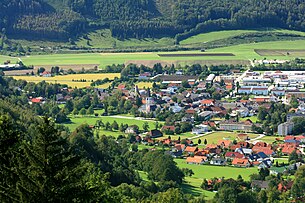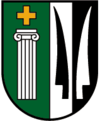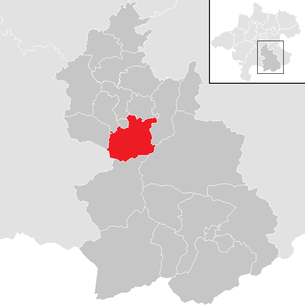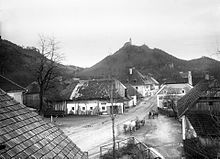Micheldorf in Upper Austria
|
market community Micheldorf in Upper Austria
|
||
|---|---|---|
| coat of arms | Austria map | |
|
|
||
| Basic data | ||
| Country: | Austria | |
| State : | Upper Austria | |
| Political District : | Church Village | |
| License plate : | AI | |
| Surface: | 50.32 km² | |
| Coordinates : | 47 ° 53 ' N , 14 ° 8' E | |
| Height : | 465 m above sea level A. | |
| Residents : | 5,878 (Jan 1, 2020) | |
| Population density : | 117 inhabitants per km² | |
| Postal code : | 4563 | |
| Area code : | 07582 | |
| Community code : | 4 09 08 | |
| NUTS region | AT314 | |
| Address of the municipal administration: |
Rathausplatz 1 4563 Micheldorf in Upper Austria |
|
| Website: | ||
| politics | ||
| Mayor : | Horst Hufnagl ( SPÖ ) | |
|
Municipal Council : (2015) (31 members) |
||
| Location of Micheldorf in Upper Austria in the Kirchdorf district | ||
 View of Micheldorf |
||
| Source: Municipal data from Statistics Austria | ||
Micheldorf in Upper Austria (until 1951 only Micheldorf ) is a market town in Upper Austria in the Kirchdorf an der Krems district in the Traunviertel with 5878 inhabitants (as of January 1, 2020). The responsible judicial district is Kirchdorf an der Krems.
geography
Geographical location
Micheldorf in Upper Austria lies at an altitude of 465 m above sea level. A. in the Traunviertel. At 1604 meters, the Kremsmauer is the highest point. The Krems rises in Micheldorf . The extension is 9.1 km from north to south and 8.7 km from west to east. The total area is 50.1 km². 50.5% of the area is forested, 38.1% of the area is used for agriculture.
Community structure
The municipal area previously comprised the following 20 localities (population in brackets as of October 31, 2011):
- Old Amber (95)
- Atzelsdorf (141)
- Eisbach (11)
- Heiligenkreuz (354)
- Hilbing (18)
- Hinterburg (177)
- In the kingdom of heaven (8)
- In the Krems (92)
- Kienberg (106)
- Kremsdorf (162)
- Micheldorf (3299)
- Upper Wienerweg (89)
- Ottsdorf (196)
- Rinnerberg (7)
- Nice (216)
- Seebach (212)
- Thurnham (79)
- Lower Wienerweg (171)
- Weinzierl (307)
- Weinzierler Bridge (118)
Today the community consists of one village (the number of inhabitants in brackets as of January 1, 2020):
- Micheldorf (5878)
The community consists of the cadastral communities Mittermicheldorf, Obermicheldorf and Untermicheldorf.
Neighboring communities
| Inzersdorf in the Kremstal |
Schlierbach Kirchdorf an der Krems |
Oberschlierbach |
| Steinbach am Ziehberg |

|
Grünburg |
|
Grünau in the Almtal district of Gmunden |
Klaus | Minor |
Population development
In 1991 the community had 4,870 inhabitants according to the census, in 2001 it had 5,615 inhabitants.
| Population development |
|
|---|---|
| date | Residents |
| 1869 | 3,000 |
| 1880 | 2,871 |
| 1890 | 2,832 |
| 1900 | 2,864 |
| 1910 | 2,968 |
| 1923 | 2,826 |
| 1934 | 3,070 |
| 1939 | 2,777 |
| 1951 | 3,658 |
| 1961 | 3,767 |
| 1971 | 4,269 |
| 1981 | 4,570 |
| 1991 | 4,870 |
| 2001 | 5,589 |
| 2009 | 5,969 |
history
Early days: Celts and Romans
Due to the favorable location at the end of the Krems valley, the area of today's Micheldorf was already permanently populated in the Palaeolithic and Neolithic . A settlement continuum of more than 4000 years seems to be demonstrable. Finds indicate that the Humsenbauernkogel near the Krems was as early as 2000 BC. Was permanently settled. Towards the end of the Bronze Age, the Illyrians reached the Krems Valley. A refuge castle protected by a double wall was built on the Georgenberg. The immigration of the Celts is believed to have been around 400 BC. Be done. The area around Micheldorf became part of the Kingdom of Norikum . The advance of the Romans to the Danube (15 BC) meant an economic boom for the region. Following a prehistoric road across the Pyhrn Pass , the Romans built a post road to Ovilava ( Wels ). One of the post stations on this street was Tutatio in the area of today's Micheldorf, named after the Celtic deity Teutates , who was worshiped on the Georgenberg .
Middle Ages: first mention

After the retreat of the Romans, Alpine Slavs and later Bavaria settled. Micheldorf became part of the Duchy of Bavaria , and then part of Styria . The rule of the Dukes of Steyr ended in the Peace of Buda in 1254. In the 10th century, a document reported for the first time about the existence of a larger village in the upper Kremstal. In 1110 Micheldorf was first mentioned as Michilindorf . The word Michel means something like 'large' in Middle High German . Pernstein Castle was first mentioned in a document in 1179. The actual settlement of the upper Krems valley was completed in the 12th century.
Modern times: scythe production
In the 14th and 15th centuries, numerous scythe smiths emerged first in the Kirchdorf market and later in Micheldorf, which transformed the place into an important industrial center. Around 1594, the Micheldorfer scythe smith Konrad Eisvogel revolutionized the production of scythes by using a water-powered broad hammer instead of manually knocking out the scythe blade with a hammer. Thanks to this innovation, which took hold within a few years, it was now possible to produce around 70 scythes of significantly higher quality instead of a few pieces a day. Micheldorf developed into the center of the European scythe industry, at times 14 scythe smiths lined up on a few kilometers on the upper reaches of the Krems . The Micheldorfer scythe-making dynasties subsequently set up scythe smiths in the whole of Upper Austria, Lower Austria and Styria according to the new model, or they married or bought into existing blacksmiths. The Kirchdorf-Micheldorfer Guild , founded in 1604, has been a leader for centuries in the manufacture of Austria's most important export item. For Micheldorf's scythe smithy and subsequently its entire population, this meant astonishing prosperity for the time. Micheldorf experienced renewed settlement activity. In the 19th century, with the decline of the old guild system, a process of concentration began in the scythe industry. In the middle of the 19th century, Caspar Zeitlinger already owned four scythe factories, his successor Franz Zeitlinger five. At the end of the 19th century, 10 of the 13 remaining scythe smiths on the Krems were owned by a single family. This could not prevent their closure, which meant a phase of slow economic decline for Micheldorf.
20th century
After the First World War , emergency money had to be issued in Micheldorf in 1920 . The banknotes showed Altpernstein Castle, the Pfuster Cross and a scythe smith at work, a rather rare picture at the time. After the annexation of Austria to the German Reich on March 13, 1938, the place belonged to the Gau Oberdonau . After 1945 the restoration of Upper Austria took place. In 1966 the Gradnwerk was the last of the Micheldorfer scythe smiths to stop production. In the decades that followed, Micheldorf was able to develop from a crisis region into an economically strong community that is now home to numerous companies.
On May 13, 1996 Micheldorf was raised to the market.
Culture and sights
Museums
- Upper Austria. Scythe forge museum : The corporate culture as well as the working and living environment of the scythe forge at the time of Caspar Zeitlinger is shown in four buildings .
- Sound worlds: Here visitors can experience the sound colors of the Pyhrn-Eisenwurzen region, e.g. B. "Storms in the Dead Mountains ".
Buildings and natural monuments
- Altpernstein Castle from the 11th century, later expanded, largely preserved as it was built. Parts of the castle are freely accessible: the baroque castle chapel , the castle dungeon , the knight's hall
- Georgenberg , mountain cone with a baptismal and wedding church. Archaeological finds since the Celtic times .
- Parish church in Heiligenkreuz : A small late Gothic sacral building that was consecrated in 1534. The nave has a single nave with a choir with a 5/8 end .
- Pfusterkreuz: Baroque wrought iron grave cross of the Kaltenbrunner family of scythesmiths from the 18th century.
- Sengsschmiedroas: Signposted themed trail along the former scythe smiths on the Krems, some of which are listed as historical monuments.
- Alpine pool with grad pond
- Kremsmauer and Törl
- Gradnalm
Sports
- The SMBC Kirchdorf Micheldorf operates a sports airfield for glider pilots.
Regular events
- The Micheldorfer Georgiritt takes place every two years.
Upper Austria. Scythe forge museum , former scythe forge on Gries (Gradnwerk)
Economy and Infrastructure
traffic
Micheldorf is on the Pyhrn A9 motorway and can be reached via the Inzersdorf-Kirchdorf or Klaus exits . In addition, the Pyhrnpass Straße B138 runs through Micheldorf.
Micheldorf can be reached by rail via a Pyhrnbahn train station.
Companies
- EMO extrusion molding
- High Tech Extrusion Group
- ifw Manfred Otte GmbH
- RIKA - Innovative Ofentechnik GmbH
- TCG Unitech system technology
politics
Municipal council
The municipal council consists of 31 members and has been made up of mandates from the following parties since the 2015 municipal council election:
- 13 SPÖ - provides the mayor
- 7 FPÖ - provides a vice mayor
- 7 ÖVP - provides a deputy mayor
- 3 greens
- 1 non-party
mayor
Mayor was Federal Councilor Ewald Lindinger of the SPÖ from October 1991 to January 2018 . In April 2018 Horst Hufnagl (SPÖ) was elected as his successor as mayor.
1st Vice Mayor is Werner Radinger (SPÖ), 2nd Vice Mayor Patrik Reiter (FPÖ), 3rd Vice Mayor Gerhard Weinberger (ÖVP).
Mayor since 1850:
- 1850 Caspar Zeitlinger , scythes
- 1861 Mathias Hoislbauer, farmer
- 1864 Michael Weinmeister , scythes
- 1867 Mathias Hoislbauer, farmer
- 1868 Franz Zeitlinger , scythes
- 1873 Franz Führinger, innkeeper
- 1876 Kaspar Strasser, innkeeper
- 1879 Franz Zeitlinger, scythes
- 1880 Mathias Tretter, farmer
- 1884 Alexander Moser, scythes
- 1885 Johann Weyermayr
- 1887 Johann Schlager, farmer
- 1891 Franz Weyermayr, farmer
- 1903 Franz Hebesberger, farmer
- 1906 Franz Hofinger, mill owner
- 1909 Franz Hebesberger, farmer
- 1912 Franz Hofinger, mill owner
- 1918 Josef Riesenhuber, community doctor
- 1919 Kaspar Strasser, wood wool producer
- 1924 Josef Riesenhuber, community doctor
- 1929 Michael Oberndorfinger, innkeeper
- 1934 Franz Döttlinger, innkeeper (employed by the Fatherland Front )
- 1938 Otto Strutzenberger, typesetter ( prov. Installed by the NSDAP )
- 1938 Johann Berger, saddler and master upholsterer ( prov. Appointed by the NSDAP )
- 1945 Leo Mauhart, Bundesbahn pensioner (appointed by the American military government)
- 1950 Michael Oberndorfinger, innkeeper
- 1955 Franz Zwicklhuber, worker
- 1958 Josef Gumpenberger, mechanic
- 1967 Fritz Rubey, elementary school director
- 1976 Dieter Heidlmaier, judicial officer (SPÖ)
- 1991 Ewald Lindinger , Federal Railroad Official (SPÖ)
- 2018 Horst Hufnagl (SPÖ)
coat of arms
Blazon : Split; on the right, in green, a silver, Ionic column, raised by a golden, equal-armed cross; on the left split by silver and black with two upright plow knives (six) in alternating colors with the edges turned outwards.
The community colors are red-white-green.
The municipal coat of arms was awarded in 1975 by the Upper Austrian provincial government. The column with the cross refers to the continuous use of the Georgenberg from a Celtic-Roman sanctuary to an early Christian church to today's Georgikirche, a landmark of the community. The plow knives are the main coat of arms of the Jörger family , who were in the possession of the Pernstein Castle and Lordship from 1529 to 1620.
Personalities
Honorary citizen
- Johann Balthasar Spiegel, 1st municipal secretary of Micheldorf
- Karl Schiedermayr
- Max Edlbacher
- Peter Jakob Denkgott, pastor of Heiligenkreuz
- Josef Weyermayr
- Johann Kröpl
- Heinrich Angermayr
- Franz Hofinger
- Raimund Kienmoser, District Captain of Kirchdorf
- Mark W. Clark , Commander in Chief of the Americ. Occupation troops
- Josef Hofer
- Anton Müller, sawmill owner
- Father Josef Stögmüller
- Dieter Heidlmaier
Sons and daughters
- Konrad Eisvogel , scythe smith, inventor of the Breithammer
- Caspar Zeitlinger (1798–1866), scythe manufacturer
- Carl Zeitlinger (1864–1937), Austrian dialect poet
- Johann Michael Zeitlinger (1803–1860), scythes
- Alois Gföllner (* 1928), politician
- Alois Wolf (* 1929), linguist and literary scholar
People related to the place
- Johann Palisa (1848–1925), Austrian astronomer, was a frequent summer guest in Micheldorf
- Hans August Freiherr von Hammerstein-Equord (1881–1947), Austrian writer and concentration camp survivor, lived and died in Micheldorf
- Carl Anton Reichel (1874–1944), Austrian graphic artist and painter, lived and worked at the Edelhof in Micheldorf
- Gerardo Reichel-Dolmatoff (1912–1994), Austrian anthropologist, spent his childhood at the Edelhof in Micheldorf
- Wilhelm Kienzl (1857–1941), Austrian composer, was often a guest in Micheldorf
- Anton Bruckner (1824–1896), Austrian composer, was a guest in Micheldorf several times and allowed himself to be carried to Altpernstein Castle on Carl Zeitlinger's back
- Franz Ferdinand von Österreich-Este (1863–1914), heir to the Austro-Hungarian throne, was a hunting guest on the Gradnalm in 1894
- Crown Prince Rupprecht of Bavaria (1869–1955), lived on the Gradnalm on the run as a result of the overthrow of 1918
- Carl Adam Kaltenbrunner (1804–1867), Austrian poet, describes in several of his works the Micheldorfer scythe works, from which he descends
literature
- Franz Neumeyer: Heimatbuch Micheldorf . 1997.
Individual evidence
- ↑ Changes to the community from 1945 (associations, partitions, name and status changes). Statistics Austria, p. 149 , accessed on February 15, 2019 .
- ↑ Statistics Austria, register census from October 31, 2011
- ↑ Statistics Austria: Population on January 1st, 2020 by locality (area status on January 1st, 2020) , ( CSV )
- ^ Province of Upper Austria, History and Geography ( [1] )
- ^ A b orf.at: New mayors in Peuerbach and Micheldorf . Article dated April 22, 2018, accessed April 22, 2018.
- ↑ Herbert Erich Baumert: The coats of arms of the cities, markets and communities of Upper Austria (4th supplement 1973-1976) , in Oberösterreichische Heimatblätter, Issue 1/2, 1977, pp. 17-18, online (PDF; 3.5 MB) in the OoeGeschichte forum .at
- ^ State of Upper Austria, coat of arms of the municipality of Micheldorf. Retrieved March 22, 2019 .
Web links
- Website of Micheldorf in Upper Austria
- Further information about the municipality of Micheldorf in Upper Austria can be found on the geographic information system of the state of Upper Austria .












